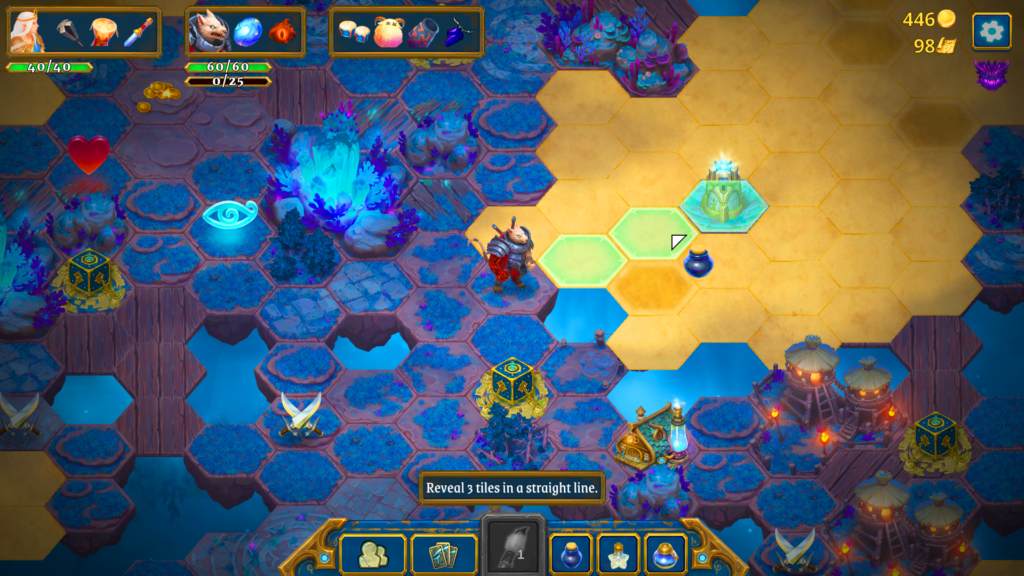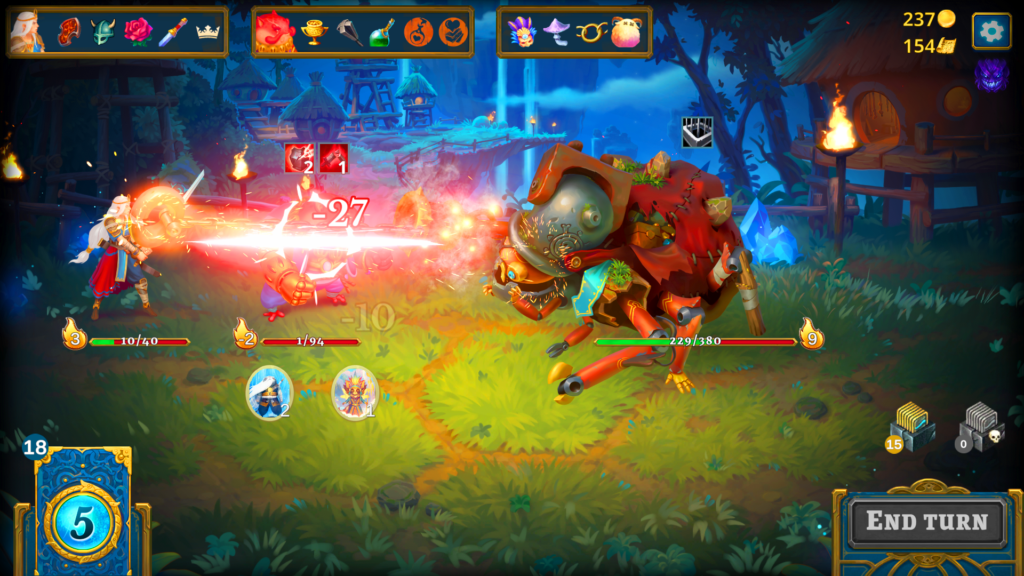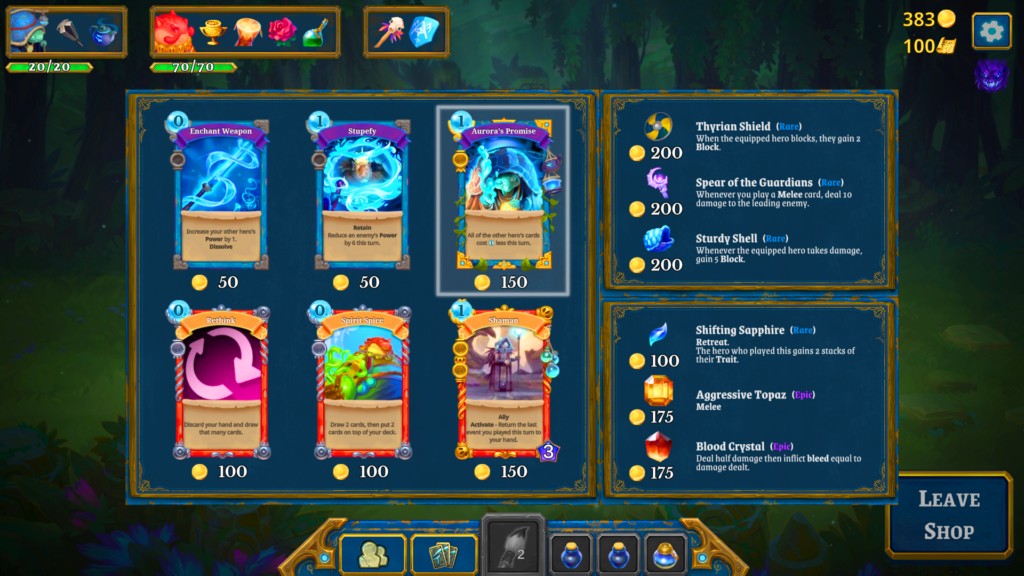It’s been years since I was an active video game reviewer, but when I was offered a review copy of the roguelike deck builder ROGUEBOOK for the Switch, I jumped at the chance. The email billed the game as being for people who liked Slay the Spire and Monster Train, and friends, I am extremely that person.
Core Gameplay
Roguebook tells the story of two heroes, Sharra and Sorocco, as well as two other heroes you can unlock along the way, Seifer and Aurora. Trapped in a book of legends, you use ink and brushes to reveal the hex map of each chapter-world, piece by piece. If the tower map of STS or the train stops of MT were encounters you could take on in any order, potentially hitting as few as 3-4 encounters per chapter, you’d have the idea. The map adds a lot of visual interest and puzzle-solving to the game format.

The hexcrawl portion is also the heart of the game’s reward structure. You do get rewards from standard fights (some gold and some ink) and elite fights (another brush, gold, permanent advancement currency, and so on), but there are enough undefended rewards scattered around that you’re trying to circumvent them as much as anything. I’ve only scratched the surface of the random events that can crop up in the hexcrawl portion of the game, in the almost-a-week I’ve been playing so far.
The point of all the cards, of course, is combat. The flow of combat is very familiar to anyone who has played STS or MT, except that there are two heroes rather than one, and a lot of cool quirks and characterization flow out of being in or benefiting from the leading (rightmost) or back (leftmost) position. Many cards and treasures allow or reward switching position, and some debuffs from enemies always affect the lead position (that’s how the game represents an aura) rather than sticking to their initial target.

Each turn, you draw five cards and reset to three energy. Treasures, allies, and other effects can change any of this up or down, as you probably expect. Cards cost anywhere from 0 to 12 energy (that 12-energy card has a built-in cost reducer), with the majority of cards at 1 energy. Dealing damage and building up enough Block to handle incoming damage are the main functions, though they add a ton of wrinkles to that like, as with any combat card game.
One of the biggest differences between Roguebook and other deckbuilding games I’ve seen is that this game doesn’t favor lean decks or card elimination, though it does still use unplayable cards as markers for detrimental effects. Roguebook is all about that big deck energy – you unlock upgrades for just the length of your current run when your deck reaches 14 cards, then 18, then 22, and so on. You still start with relatively weak cards that you can transmute or upgrade with gems.
Beating elites and bosses gives you Pages; you also collect pages during hexcrawl exploration. Pages are your permanent upgrade currency, which the game calls Embellishments. There’s a whole talent tree, and I’ve unlocked the early tiers but can’t see that deep into the tree yet. I wonder how much value the game gets out of holding back those options and only revealing them later.
Quibbles
I have a lot of good to say about this game that I’m rushing past, but there are also a few rough patches that I have to call out. Well, one really egregious one: the text size on cards is WAY too small, whether I’m playing on the handheld Switch or on my 50-inch TV screen. I’m 40 and my eyesight is no great shakes, but this promises to be a whole problem for many users.

I also expected the game to be harder, I think, and to have a stronger sense of tension and climax in Chapter Three. The early game has some make-or-break moments, but by Chapter Two I’m often sailing through a lot of encounters. My first full win was on my third run, and I didn’t know for sure at the time that there wasn’t about to be a fourth chapter. I stomped that boss flat and was left with a certain sense of “oh, is that all there is…?” Maybe there’s a final-final boss, comparable to the Corrupted Heart or Hades (from, you know, Hades), that I haven’t unlocked yet.
Now, that said, the game does have a progression of harder modes (Epilogues), and I’m just dipping my toe into those waters. You mix-and-match to choose the form of your destroyer, much like the Pact of Punishment in Hades. I can’t see what the higher-level options are, but I’m sure I’ll hit a point where the game has the level of difficulty I’m instinctively expecting.
Overall
Let’s hit the highlights:
- This game has a lot to offer to any fan of deckbuilders.
- It’s a great intro to the genre for anyone else.
- Clever card interactions feel just as amazing in this game as they do in any good card game.
- I’m not sure, guys, but I think Richard Garfield might have a bright future in card game design.
- Ahem.
- The card interactions are easy to understand, which is a huge boon in a deckbuilder.
- The character and monster visual design are great in combat.
- The events are well-written and compelling.
- The puzzle elements of the hexcrawl feel outstanding.
- There’s a lot of this game left for me to see even after two successful runs, and I expect to keep playing on into high Epilogue levels.
STRONGLY RECOMMENDED FOR GENRE FANS, 8.5/10
Roguebook came out for the PC in 2021, and is now available on the PS4, PS5, Xbox One, Xbox Series S, Mac, and Linux. It comes to the Nintendo Switch today, so go check it out!

